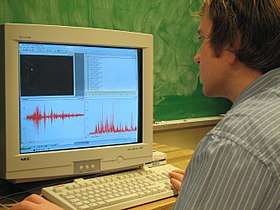
Back Elektromiografie Afrikaans تخطيط كهربائية العضل Arabic Elektromioqrafiya Azerbaijani Electromiografia Catalan Elektromyografie Czech Elektromyografi Danish Elektromyografie German Electromiografía Spanish Elektromiografia Basque نوار عصب و عضله Persian
| Electromyography | |
|---|---|
 EMG from gait termination, bottom left is the raw EMG, right is the rectified pattern | |
| ICD-9-CM | 93.08 |
| MeSH | D004576 |
Electromyography (EMG) is a technique for evaluating and recording the electrical activity produced by skeletal muscles.[1][2] EMG is performed using an instrument called an electromyograph to produce a record called an electromyogram. An electromyograph detects the electric potential generated by muscle cells[3] when these cells are electrically or neurologically activated. The signals can be analyzed to detect abnormalities, activation level, or recruitment order, or to analyze the biomechanics of human or animal movement. Needle EMG is an electrodiagnostic medicine technique commonly used by neurologists. Surface EMG is a non-medical procedure used to assess muscle activation by several professionals, including physiotherapists, kinesiologists and biomedical engineers. In computer science, EMG is also used as middleware in gesture recognition towards allowing the input of physical action to a computer as a form of human-computer interaction.[4]
- ^ Robertson, D. G. E.; Caldwell, G. E.; Hamill, J.; Kamen, G.; Whittlesey, S. N (20 January 2014). Electromyographic Kinesiology, Research Methods in Biomechanics. Champaign, IL: Human Kinetics. ISBN 978-0-7360-9340-8. OCLC 842337695.
{{cite book}}:|journal=ignored (help) - ^ Paoletti, Michele; Belli, Alberto; Palma, Lorenzo; Vallasciani, Massimo; Pierleoni, Paola (June 2020). "A Wireless Body Sensor Network for Clinical Assessment of the Flexion-Relaxation Phenomenon". Electronics. 9 (6): 1044. doi:10.3390/electronics9061044. ISSN 2079-9292.
- ^ Electromyography at the U.S. National Library of Medicine Medical Subject Headings (MeSH)
- ^ Kobylarz, Jhonatan; Bird, Jordan J.; Faria, Diego R.; Ribeiro, Eduardo Parente; Ekárt, Anikó (2020-03-07). "Thumbs up, thumbs down: non-verbal human-robot interaction through real-time EMG classification via inductive and supervised transductive transfer learning". Journal of Ambient Intelligence and Humanized Computing. 11 (12). Springer Science and Business Media LLC: 6021–6031. doi:10.1007/s12652-020-01852-z. ISSN 1868-5137.
© MMXXIII Rich X Search. We shall prevail. All rights reserved. Rich X Search